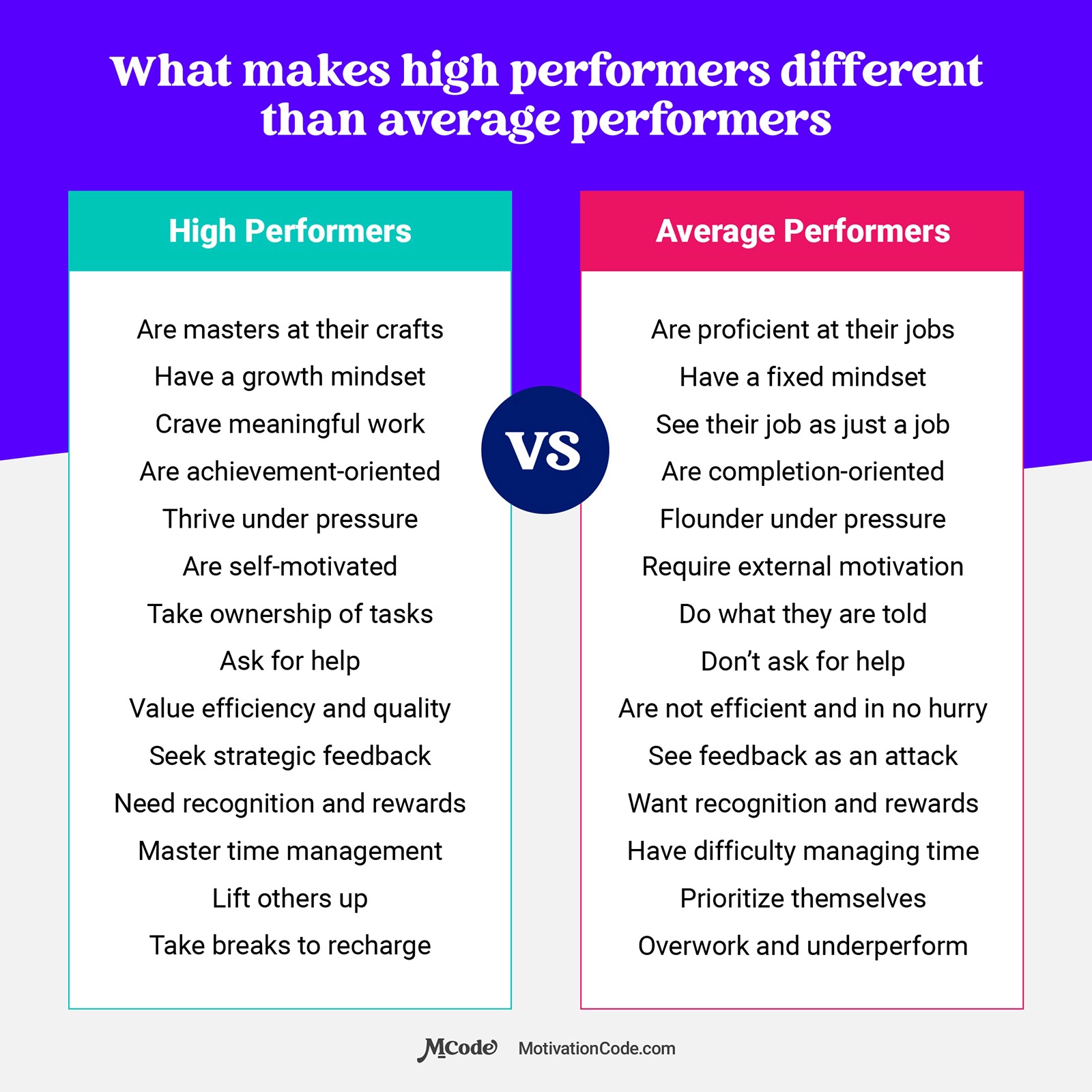The most successful organizations aim to hire and retain high-performers. They spend countless dollars to recruit high-performance employees and build high-performance teams, and they invest in training their leaders to better engage and manage high performers.
You might be wondering why and asking, “What’s all the fuss? What makes high-performing employees so valuable to a team or organization?”
The short answer is that high performers are more productive.
- Top performers generate 2.6 times the sales ROI of average employees.
- High achievers in high-complexity roles are up to 800% more productive than their average performing counterparts.
- High performers are up to 400% more productive than the average performer.
The long answer is they make a serious impact.
High performers consistently exceed expectations, introduce fresh perspectives, elevate teams, drive remarkable results, and achieve exceptional outcomes.
They also inspire team members to hold themselves to higher standards. Researchers at the Kellogg School of Management at Northwestern University looked at the 25-foot radius around high-performers at a large technology firm and found that these workers boosted performance in coworkers by 15%. That “positive spillover” translated into an estimated $1 Million in additional annual profits.
High-performing companies cultivate high-performing talent
From entrepreneurs to small businesses to enterprises, savvy employers know their people are their greatest assets and the hearts of their organizations. They also know that to remain competitive, they must:
- Recruit exceptional talent — the same in-demand talent competitors are looking for.
- Identify and cultivate high-performing talent so they remain engaged and happy.
- Retain their best and brightest employees so competitors don’t steal them.
Competition for high-performance employees isn’t new. It is so prolific that it was referred to by McKinsey as the war for talent as early as 1997 — a still fitting description as competition for talent is only becoming more fierce.
High performers vs. average performers
High performers are simultaneously marveled at and disliked. Some people are fascinated by their motivation and consistent extraordinary performance, while others are intimidated by their drive to succeed and insecure about how they compare.
If you are an executive, leader, or manager, you must become an expert at identifying high performers and recognizing how a high-performing employee is different from any other employee. It’s the first step to cultivating your best, most irreplaceable talent and ensuring they feel seen, supported, valued, and appreciated for the contributions they make to the team and the broader organization.
Here’s how high performers stand out from average employees:

High performers are masters at their crafts
Average employees are generalists who are good at their jobs and proficient in relevant skills.
High-performing employees are specialists who are extraordinary at their jobs and often the best at what they do. They bring deep knowledge and expertise in a specific area and contribute a specific benefit to their teams and companies. They can be counted on to produce beyond standard norms, delivering at the highest quality or next level.
High performers have a growth mindset
Moderate achievers have fixed mindsets and are content with the skills they have.
High achievers have growth mindsets — they constantly seek personal and professional growth. Not content with the status quo, they are always learning, improving their skills, honing their crafts, and looking for new ways to be more effective and efficient.
High achievers also seek new challenges and opportunities to push beyond the boundaries of their current skills and what they already know. But don’t assume they want to be pushed out of their comfort zones all the time. Yes, they need opportunities to hit home runs and make the crowd go wild, but between those larger initiatives, they also need regular assignments aligned with their strengths and core motivations so they can make consistent base hits and win often.
High performers crave meaningful work
Average performers see their job as just a job. Their purpose is to check off their to-do lists and collect their paychecks.
Not content with low-level busy work, high performers want their work to mean something and matter. They want to understand the vision and purpose of their projects, know how their role fits into the big picture, know their work makes an impact, and contribute significantly to the outcome, team, or organization. They also prefer to have a central role in solving problems and have a voice in conversations about possibility and process.
High performers are achievement-oriented
Ordinary employees strive to hit their performance metrics and deliver the expected results. They don’t put in extra effort and avoid extra work.
High-performance employees strive to blow past their performance metrics. When you set a target for a high performer, they think, “If this is what you think I can achieve, just wait until you see what I deliver.”
They are gold-star goal seekers who aim to exceed the expected results and achieve extraordinary outcomes that ensure they stand out and impress. They are energized when given a goal others may deem impossible and motivated to prove they can do it, overcome any obstacle in their paths, and make it happen.
High performers thrive under pressure
Mediocre employees shrink and flounder under pressure. When facing a challenge, they let the fear of failure and feelings of inadequacy control their behavior, which leads to procrastination and weak performances.
Superstar employees thrive and flourish under pressure. When facing a challenge, they focus on the goal and demonstrate exceptional effort, perseverance, grit, and resilience. They are not afraid to try new things, adapt and pivot quickly, and are willing to fail and keep trying if it makes them better or produces a better outcome.
High performers are self-motivated
Basic workers need external motivation — extra pushes and more accountability from their managers — to rise to the occasion and give their best.
High-functioning workers are self-motivated to accomplish tasks and naturally driven to do their best. They thrive when given high levels of autonomy and freedom.
As people who regularly reflect on and assess their skills, performance, values, emotions, and behavior to better understand how to be the best version of themselves, your highest functioning employees have a strong sense of self-awareness. They know who they are, where their strengths lie, and what they need to get motivated and stay motivated.
High performers take ownership of tasks
Regular performers are reactive team members who are happy to let someone else take the lead and be told what to do.
Top performers are proactive team members who take ownership of tasks and responsibilities and are comfortable operating in leadership roles. While they take deep pride in their work and often play a key part in initiatives’ success, they are just as motivated by others’ success or their team’s success as their own.
As natural problem solvers and strategic thinkers, you can count on your top performers to do whatever it takes to get a job done and drive a team over the finish line.
High performers ask for help
Low-value employees are afraid to say “I don’t know” or admit they need help, worrying that it will make them look inferior or incompetent. Their inability to raise their hands keeps them stuck and wastes time.
High-value employees have no problem saying “I don’t know” and seek help when they need it because they know what’s at stake if they stay stuck and fail to raise their hands early. Their ability to separate their personal worth and value from their professional work, means they view asking for help as accessing a tool in their toolbox rather than a sign of weakness.
High performers value efficiency and quality
For average-performing employees, good enough is good enough. These inefficient employees meander through their workdays, get easily distracted, and lose track of time. They are in no hurry to finish the tasks at hand.
For top-performing employees, good is never good enough. They want to be great, do great work, and find the most efficient approach or solution without sacrificing quality. Many are perfectionists or recovering perfectionists.
Leaders and managers say top performers go above and beyond, but top performers don’t see it that way. It’s just how they operate. They struggle to give less than 100% and hold themselves and their work to the highest standards of excellence, seeing efficient, effective, productive, quality work as the norm.
High performers seek strategic feedback
Your standard workers receive feedback when they are required to, but don’t seek it out. They take critique personally and do not respond well to constructive criticism, viewing it as a personal attack.
Your best workers crave feedback and actively seek it out. They don’t take critiques or criticism personally as long as it comes from someone they respect, and it is clearly well thought out, strategic, constructive, and meaningful feedback. High performers use feedback loops as a way to receive recognition and validation and identify opportunities for improvement and growth.
High performers need recognition and rewards
When it comes to recognition and rewards, high-performing and low-performing employees aren’t all that different. While the type of recognition and rewards desired depends on employees’ unique motivational patterns, everyone wants recognition for their efforts and rewards for their achievements.
The difference between the two types of employees is how they respond to not receiving recognition and rewards.
Low-performing employees will keep on truckin’ and not much will change, as they didn’t go out of their way to get the job done anyway. High-performing employees who worked hard, gave their best, and exceeded expectations, however, might think twice about how much effort they contribute the next time you assign them a task. Ignoring the efforts and accomplishments of top performers can slowly chip away at their motivation and productivity.
High performers master time management
Employees who perform at the standard level have not mastered time management. They have not yet established their “way of working” or the process they follow to perform at their best, which causes them to focus on the wrong things and waste time.
Employees who perform at the highest level are disciplined time management masters. They have experimented with different productivity methods and developed work routines that support high performance. They are intentional in planning their weeks and are proactive about designing their days around their most important projects.
Most high performers have cultivated specific habits and rituals they rely on to get in the groove, tune out distractions, focus deeply, and move fast, which makes their levels of productivity seem almost superhuman.
High performers lift others up
Decent employees put themselves first and prioritize their individual success. They contribute to the team but not at the expense of making themselves look good, and when things don’t go their way they complain and introduce negativity.
High-impact employees put their teams first and prioritize the collective goal or objectives. They exude positivity and want everyone to succeed individually and as part of the team. They help team members by offering encouragement, sharing knowledge, teaching skills, and modeling high-performance habits.
High performers take breaks to recharge
It sounds counterintuitive but low performers work and work and work without taking necessary breaks. Because they overwork and teeter on the brink of exhaustion, they experience burnout more frequently. This negatively impacts creativity, strategic thinking, and productivity. They’re like hamsters running fast on their wheel and getting nowhere.
Against a deadline, high performers can work longer and harder than anyone else because they have prepared for that moment. They know to run fast they also need to rest.
High performers take breaks during the workday, in the evenings, and over weekends. They also typically use all of their vacation days. They know that the secret to high performance is practicing self-care and giving their bodies and minds time to rest, refuel, and recharge.
Just as an elite athlete rests during the off-season, doing only conditioning to stay in shape, high performers rest between big pushes or sprints, doing work that sits squarely in their sweet spot or zone of genius.
This doesn’t mean high performers don’t experience burnout. They do. They likely have experienced it more than once. They just don’t want to experience it again. They have learned to recognize the factors that lead to exhaustion and burnout and avoid or mitigate them as much as possible.
Motivation Code helps you identify and understand high performers
Now that you can distinguish a high performer from an average performer or low performer, you must identify the high-performing members of your team, personalize the way they are led, and provide what they need to thrive.
It sounds difficult, but for organizations that use the Motivation Code assessment as part of their team-building exercises and management training, it’s easy.
When you discover an individual’s MCode, you learn exactly what motivates them to engage, perform at their best, and relentlessly pursue the outcomes you set. You also uncover the rewards they prize most, the tasks that energize and drain them, and how they can contribute the most value to your organization while doing deeply meaningful and fulfilling work.
When teams use Motivation Code assessment, its impact is amplified. Companies see more efficient and effective collaboration, improved communication, happier and more engaged team members, and accelerated progress toward goals.
Try the Motivation Code assessment for yourself today, or reach out to chat with a member of our team to learn about introducing MCode to your organization or piloting it with your executive team.

